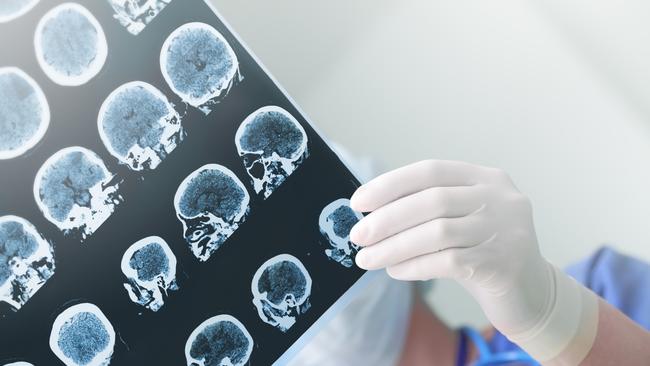Kyle Sandilands reveals he has a second aneurysm
Kyle Sandilands stunned listeners with the news of his brain aneurysm diagnosis – and now he has another worrying update.
Kyle Sandilands has revealed doctors have located an aneurysm in his chest days after revealing he had a brain aneurysm.
The shock jock told his KISS FM fans the only way to get to the aneurysm, located on the front right side of his brain, is to open his skull.
He then also revealed he will need second to extract another aneurysm which has been found in his chest.
“The [brain] aneurysm is at a Y junction and it is at the top. The shape of it has limited the operation they can do. The only option to get to it is to [open the skull],” Kyle said on Friday.
“That will mean I have this huge scar from the forehead to top of ear and they would have to drill a hole in my skull, go into the brain and clip it off.”

Kyle said the doctor told him he will have less problems “leaving it and monitoring it” until it gets bigger.
“As soon as I do any procedure my risk goes right up. He told me to take the weekend to think about it,” Kyle said.
“They found another one in my chest and that’s a separate surgery and I have very bad calcium build-up in the heart where I’m likely to have a heart attack.”
His co-host Jackie O asked: “What do you do about that?”
“I need to have surgery for that as well,” Kyle revealed.
An Australian woman revealed she underwent multiple brain surgeries after suffering from two aneurysms.
Brisbane woman Annie Barnett, then 21, shared her survival story after radio host Kyle Sandilands shocked listeners with a live announcement, revealing he’s set to undergo surgery after doctors diagnosed him with a brain aneurysm.
Ms Barnett said in the space of three months in late 2021 she had two ruptured aneurysms, a stroke and seizures, and underwent 14 surgeries.
“I woke up in the middle of the night with the most severe headache I’ve ever had,” she said, explaining that she was now on a mission to spread awareness of the condition and what the symptoms are.
In Australia, approximately 1 in 50 people are affected by brain aneurysms.
The annual rupture rate is about 8 to 10 per 100,000 people, which translates to roughly 2750 cases each year.
“On Friday, I was told by my medical team, which sounds like I’m already very sick, to have a medical team, that I have a brain aneurysm and it requires immediate attention, brain surgery,” he said on KIIS FM on Monday morning.
“If you just tuned in to us after all these years, lap it up. And if you’re in Melbourne … you’re coming to the party too late. You may get your wish. I may be dead.”
Here’s everything you need to know about this potentially life-threatening condition.
WHAT IS A BRAIN ANEURYSM?
A brain aneurysm is a weak or thin spot in a blood vessel in the brain that bulges outward, forming a balloon-like swelling.
It often develops without symptoms but can be dangerous if it leaks or ruptures, causing a life-threatening brain bleed known as a haemorrhagic stroke.
CAUSES AND RISK FACTORS
While the exact cause isn’t always clear, several factors contribute to their development.
- High blood pressure (hypertension) is a major risk, as it puts extra strain on artery walls, making them more prone to weakening.
- Smoking damages blood vessels and increases the likelihood of aneurysm formation and rupture.
- Genetic factors also play a role — people with a family history of aneurisms are at a higher risk.
- Certain medical conditions, such as connective tissue disorders (e.g., Ehlers-Danlos syndrome and Marfan syndrome), polycystic kidney disease, and arteriovenous malformations (AVMs), can weaken blood vessel walls.
- Head trauma and infections, though less common, may also contribute.
- Excessive alcohol consumption and drug use (especially cocaine or amphetamines) can increase the risk by causing sudden spikes in blood pressure.
- Ageing is another factor, as aneurysms are more common in people over 40, particularly women, due to hormonal changes that may affect blood vessels.

WHAT ARE THE SYMPTOMS
Symptoms of a brain aneurysm usually begin with a sudden and severe headache, similar to a migraine, that neurosurgeons call a ‘thunderclap headache’. Many describe these headaches as the worst they’ve ever had. Intense pain behind the eyes, sensitivity to light, stiff neck, blurred vision, confusion and seizures could all be signs of a ruptured aneurysm.
Other symptoms could include:
- Nausea and vomiting
- Seizures
- A drooping eyelid
- Loss of consciousness
HOW IS IT DIAGNOSED?
A brain aneurysm is diagnosed through imaging tests that detect abnormalities in blood vessels.
If an aneurysm is suspected, doctors may use a CT scan or MRI to create detailed images of the brain.
A CT angiography (CTA) or magnetic resonance angiography (MRA) can provide a clearer view of blood flow and aneurysm size.
In some cases, a cerebral angiogram — where a contrast dye is injected into the arteries and viewed with X-rays — offers the most detailed look.
CAN YOU HAVE AN ANEURYSM WITHOUT KNOWING?
A brain aneurysm can go undetected for years, even a lifetime, without causing any symptoms.
Many unruptured aneurysms are only discovered incidentally during brain scans for unrelated issues.
The length of time a person can have an aneurysm without knowing depends on factors like its size, location, and whether it puts pressure on surrounding brain tissue or nerves.
Small aneurysms often remain stable and may never cause problems, while larger ones or those in critical areas can eventually lead to symptoms like headaches, vision changes, or nerve pain.
In some cases, an aneurysm may suddenly rupture without warning, leading to a life-threatening brain bleed.
WHAT IS THE TREATMENT?
Treatment for a brain aneurysm depends on its size, location, and risk of rupture.
Small, unruptured aneurysms that aren’t causing symptoms may be monitored with regular imaging scans, while lifestyle changes and medications to control blood pressure and reduce strain on blood vessels are often recommended.
If an aneurysm is at risk of rupturing, surgical or minimally invasive procedures may be necessary.
The two main treatments are surgical clipping, where a metal clip is placed at the base of the aneurysm to stop blood flow, and endovascular coiling, a less invasive procedure where a catheter is threaded through the blood vessels to place tiny coils inside the aneurysm, promoting clotting and preventing rupture.
In emergencies, such as a rupture, immediate medical intervention is required to stop bleeding and prevent complications like brain damage or stroke.
After treatment, patients may need rehabilitation and ongoing monitoring to ensure long-term recovery.
WHAT IS THE LIFE EXPECTANCY?
People with aneurysms can live normal life spans, completely unaware they have one. Many aneurisms have no symptoms at all. Ruptured aneurisms can be fatal in about 50 per cent of cases, about 70 per cent of survivors have permanent brain damage, but some people recover with little or no disability.
Prognosis depends on a number of individual factors, including age, pre-existing neurological conditions, the location of the aneurysm, how much it bled, how quickly it was treated, and whether the treatment was successful.
HOW TO AVOID AN ANEURYSM?
Reducing blood pressure, dietary improvements, quitting smoking, and limiting alcohol intake can significantly lower the risk of developing an aneurysm.
Blood pressure can be reduced with regular exercise, maintaining a regular weight, cutting down on salt and eating a diet high in fruits, vegetables, and omega-3 fatty acids. Reducing stress also promotes vascular health, and any sleep issues – like obstructive sleep apnoea – should be treated. Limit alcohol consumption to one drink a day.
More Coverage
Originally published as Kyle Sandilands reveals he has a second aneurysm




